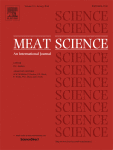Ver ítem
- xmlui.general.dspace_homeCentros Regionales y EEAsCentro Regional Buenos Aires SurEEA Cuenca del SaladoArtículos científicosxmlui.ArtifactBrowser.ItemViewer.trail
- Inicio
- Centros Regionales y EEAs
- Centro Regional Buenos Aires Sur
- EEA Cuenca del Salado
- Artículos científicos
- Ver ítem
The influence of protein restriction during mid- to late gestation on beef offspring growth, carcass characteristic and meat quality
Resumen
The objective of this study was to determine whether crude protein intake during the last three months of gestation affects growth performance, carcass characteristics and meat quality of steer progeny. At 134 ± 14 d of gestation, 68 multiparous Angus cows were blocked by BW and expected calving date and randomly assigned to diets that contained either low or high dietary crude protein concentrations and were allotted in 12 pens per treatment. After
[ver mas...]
The objective of this study was to determine whether crude protein intake during the last three months of gestation affects growth performance, carcass characteristics and meat quality of steer progeny. At 134 ± 14 d of gestation, 68 multiparous Angus cows were blocked by BW and expected calving date and randomly assigned to diets that contained either low or high dietary crude protein concentrations and were allotted in 12 pens per treatment. After calving, cows were managed together on improved pastures during lactation. After weaning at 219 ± 13 d of age, steers calves were stockered on natural pastures until 687 ± 13 d of age then placed into a feedlot for 83d before slaughter. Maternal dietary protein concentration had no influence on offspring body weight and growth rate during rearing or finishing phases (P > .10). Rib fat thickness of steers was not affected (P = .38) by maternal nutrition treatments, however, LM area was greater in HP steers than LP steers at entrance into the feedlot (P = .01) and end of finishing phase (P = .04). Hot carcass weight was similar between treatments (P = .69), however dressing percentage was increased in HP relative to LP steers (P = .01). Tenderness of Longissimus muscle was increased in HP compared to LP steers after 3 and 14d (P < .001) of aging. No treatment differences in troponin-t degradation (P = .77) and collagen content (P = .58) were observed. Muscle fiber diameter was similar in LP and HP steers (P = .20), suggesting that increase of LM area in HP steers could be due to muscle hyperplasia. These data indicated that level of protein during mid to late gestation does not affect offspring growth but has impacts on carcass composition and meat quality of steer progeny.
[Cerrar]

Autor
Maresca, Sebastian;
Lopez Valiente, Sebastian;
Rodriguez, Alejandro Martin;
Testa, Maria Laura;
Long, Nathan M.;
Quintans, Graciela I.;
Pavan, Enrique;
Fuente
Meat Science 153 : 103-108 (July 2019)
Fecha
2019-07
Editorial
Elsevier
ISSN
0309-1740
1873-4138
1873-4138
Formato
pdf
Tipo de documento
artículo
Palabras Claves
Derechos de acceso
Restringido
 Excepto donde se diga explicitamente, este item se publica bajo la siguiente descripción: Creative Commons Attribution-NonCommercial-ShareAlike 2.5 Unported (CC BY-NC-SA 2.5)
Excepto donde se diga explicitamente, este item se publica bajo la siguiente descripción: Creative Commons Attribution-NonCommercial-ShareAlike 2.5 Unported (CC BY-NC-SA 2.5)

